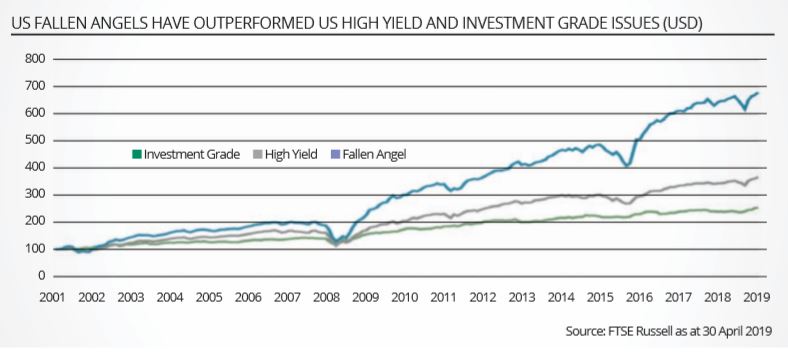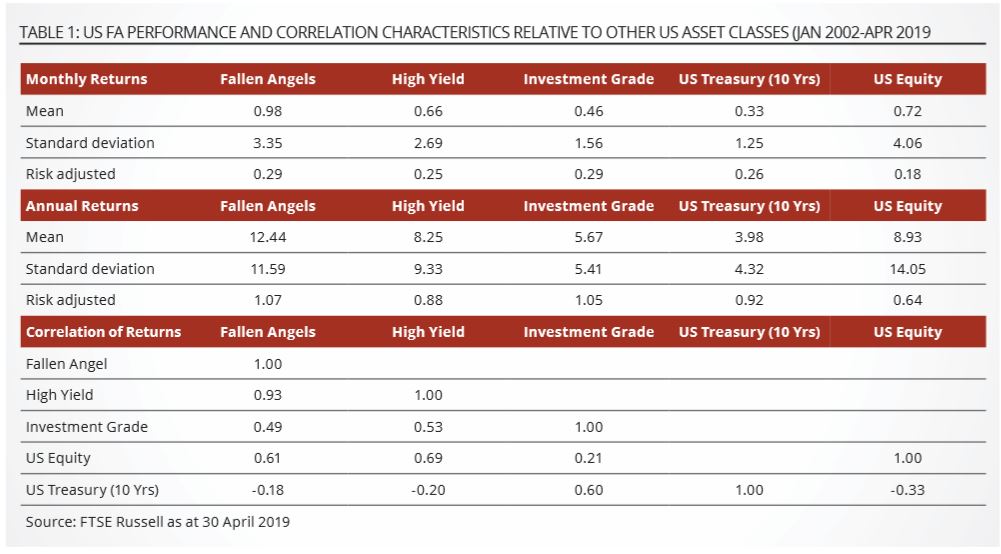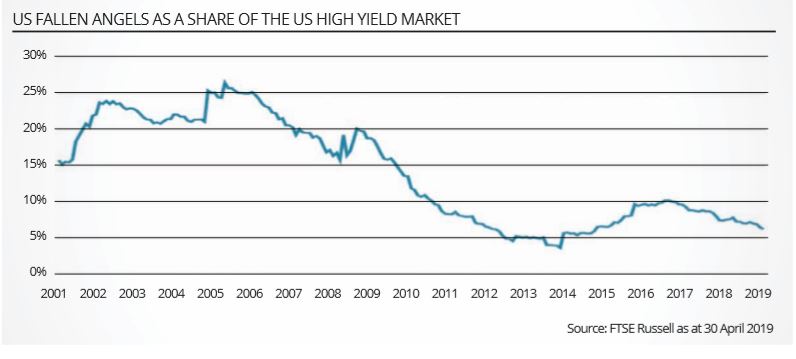When US investment grade bonds are downgraded and cross the ratings threshold into high yield territory, they join the sector known as ‘fallen angels’. Robin Marshall, director of fixed income research at FTSE Russell, examines how – and why – fallen angel characteristics and performance differ from the rest of the US high yield bond market.
What are fallen angels?
A fallen angel (FA) is a corporate or sovereign bond downgraded from Investment Grade (IG – a minimum rating of BBB- with S&P, Moody’s or Fitch – to a High Yield (HY) credit rating of BB+ or below. Since this downgrade represents a move from investment grade to speculative territory, it is far more significant than a downgrade for a bond staying within the same asset class.
Because FAs were issued as IG credits, they tend to have different characteristics than other HY issues. Most notably, by comparison FAs tend to have longer duration, lower coupons, higher credit ratings, weaker covenants (since they were issued as IG credits), and lower default rates. FAs are also generally more concentrated in sectors subject to specific shocks than HY issues.

Fallen angel performance
The number of FAs has often been negatively correlated with the economic cycle, expanding during recessions. Rating agencies seek to capture these cyclical risks in their ratings, but sector-specific shocks, like the TMT bubble in 2000, or the oil price collapse in 2014/15, can cause a spike in the number of FAs. After the GFC in 2008/09 credit ratings may now be more defensive than in previous cycles.
Fallen Angel bond indexes, like the FTSE TimeWeighted US Fallen Angel Bond Index (FABI) measure the performance of FAs after they enter the sub-IG asset class. The FABI measures the performance of bonds issued by companies domiciled in the US and Canada. As shown in the graph below, this index outperformed market cap weighted HY issues in the period 2002-2016.
Since 2002, FAs have also posted higher returns on an annual basis relative to other fixed income classes, but with more volatility. The higher volatility can at least somewhat be explained by the time period immediately following the announcement of an FA’s downgrade from IG, where empirical evidence suggests it will see the sharpest drop in performance. As such, FAs display higher standard deviation of returns than HYs (Table 1). However, FAs still reported higher risk-adjusted returns for the period not only relative to HY, but also to US Treasuries and US equities.

The correlation of returns with US equities (FTSE USA index) is also lower for FAs than HYs more generally, illustrating the slightly higher credit quality.
It is important to note that FA performance can also be impacted by different market regimes. For example, FAs and other HYs have typically underperformed IG credits and US Treasuries during a cyclical downturn. This has occurred when liquidity effects become severe and the credit carry in HYs has become strongly negative. But FAs have outperformed during cyclical upturns when credit quality improved, as was the case from 2011-16.
Paul Syms, head of EMEA ETF fixed income product management at Invesco, commented: “When we were developing our US High Yield Fallen Angels UCITS ETF that is now approaching its three-year anniversary, we selected the FTSE index to track. That is largely because we believed the innovative time-weighted approach would be the best way to capture the performance of this asset class. Investors looking at the ETF may be attracted to both the growth potential of fallen angels and also the relatively high yields.”
Why fallen angels have had higher risk-adjusted returns
FAs’ outperformance in the corporate bond market can in large part be attributed to overselling, which drives FAs to artificially low prices relative to equivalent credits in the HY asset class. This can occur for several reasons. First, after the downgrade to sub-investment grade, indexed IG funds and other funds that are not permitted to hold sub-IG issues are forced to sell the FA.
The other two factors driving the overselling of FAs relate more to behavioral finance. Institutional investors can overreact to the news of a downgrade, further causing the bond to suffer a “cliff-edge” effect on departure from the IG asset class. And in some cases, the selling can start even before the downgrade is announced. Given the distinct nature of IG and HY, even the risk of an issue leaving the IG universe can cause advance selling of the bond, because an active IG portfolio manager wishes to avoid being caught with a sub-IG holding.
More generally, there is some evidence regulated investors can exploit sluggish adjustment in credit ratings to conduct regulatory arbitrage, taking advantage of the difference between actual credit risk and the risk implied by imperfect credit ratings. FAs also benefit from a higher proportion of subsequent credit upgrades than equivalent HY issues. This may be because previous spikes in the proportion of FAs have reflected temporary financial pressure on longstanding businesses.
FAs’ unique characteristics can also be performance drivers. As noted earlier, FAs tend to have more duration than the rest of the HY asset class, since HY issuers may struggle to issue longer maturity bonds. This would have helped relative performance during the 2011-16 period, given very low interest rates and a benign credit environment.

How market regimes shape the fallen angel market
The size of the fallen angels sector can largely be a function of market regime. Several indicators can help investors assess the potential changes in the number of FAs, including macroeconomic indicators like the credit cycle and monetary policy, as well as aggregate credit indicators like the ratio of upgrades to downgrades.
The risk of sector-specific market shocks is also a key indicator to follow when looking to gauge potential changes in the size of the FA market. When studying past sector-specific market shocks, the impact on the size of the FA market is evident. As shown in the graph above, the share of FAs in the overall HY market was much higher after the sector-specific shocks in 2014/15 (energy sector), 2008/09 (financials), 2001/02 (TMT).
Looking at the current FA market, both default rates (DRs) and the share of FAs in the HY market remains low by historical standards, despite weakening global growth and the general decline in the credit quality of market indexes. This may be due to a long period of stable US corporate earnings growth, a decrease in the use of key covenants for non-IG bonds, and the absence of a recent sector-specific shock.
Of course, it is quite possible that the share of FAs in the HY market now increases as generally happens in a downturn, but credit ratings are already more defensive, and the build-up of BBB debt may be partly M&A driven. Companies also have a strong incentive to avoid migration into the HY market, given the increase in the cost of capital that follows when credits lose their IG status.
Conclusion
While FAs are categorized as HY bonds upon crossing the ratings threshold into sub-IG, they can in fact be quite different with respect to both characteristics and performance. When studied as a distinct asset class, FAs have historically exhibited higher risk-adjusted returns than HY issues. This is primarily due to overselling, where both forced IG fund sellers and general overreaction to news of the downgrade can drive FA bonds to artificially low prices relative to equivalent credits in the HY asset class.
The size and composition of the FA market can shift over time, and is largely a function of market regime. While the current share of FAs in the HY market is historically low, there are several key indicators that could reshape the FA landscape. Looking at these indicators can help investors assess the potential changes in the number of FAs.
Robin Marshall is director, fixed income research at FTSE Russell
This article first appeared in the Q3 2019 edition of our new publication, Beyond Beta. To receive a full copy, click here.



